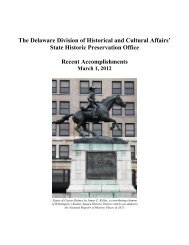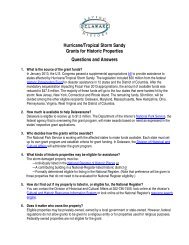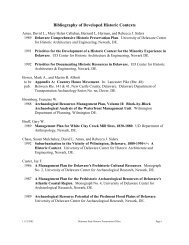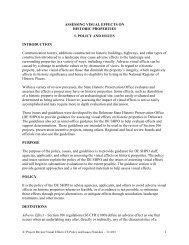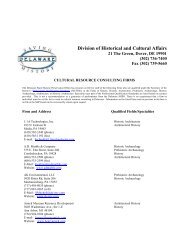Report of the Archaeological Investigations of the New Castle Court ...
Report of the Archaeological Investigations of the New Castle Court ...
Report of the Archaeological Investigations of the New Castle Court ...
You also want an ePaper? Increase the reach of your titles
YUMPU automatically turns print PDFs into web optimized ePapers that Google loves.
3.5.4 BURNT AREA ADJACENT TO THE 1845 ADDITION<br />
NEW CASTLE COURT HOUSE PLAZA<br />
NEW CASTLE, DELAWARE<br />
3.0 FIELD RESULTS<br />
Although a dark stain was noted during <strong>the</strong> excavation <strong>of</strong> EUs 18 and 19, feature identification<br />
was not made until <strong>the</strong> remainder <strong>of</strong> <strong>the</strong> foundation material was removed during <strong>the</strong> plaza<br />
stripping. At this time, <strong>the</strong> morphology <strong>of</strong> Feature 93 became obvious. This area represents a<br />
large burnt area at <strong>the</strong> top <strong>of</strong> <strong>the</strong> subsoil in front <strong>of</strong> <strong>the</strong> 1845 wing (Figure 6; Plate 6). The overall<br />
feature dimension is tentative due to <strong>the</strong> incomplete removal <strong>of</strong> foundation material during <strong>the</strong><br />
stripping, but it seems to overlie <strong>the</strong> highest part <strong>of</strong> <strong>the</strong> landform. The estimated dimensions <strong>of</strong> <strong>the</strong><br />
extant portion are 10.7 by 7 ft. and based on <strong>the</strong> section that was excavated in EUs 18 and 19; <strong>the</strong><br />
feature appeared to be roughly 0.2 ft. thick. Although this feature cannot be absolutely dated, it<br />
does appear to be one <strong>of</strong> <strong>the</strong> earliest features present within <strong>the</strong> western plaza section. It is cut by<br />
<strong>the</strong> 1845 builder’s trench (Feature 49), <strong>the</strong> circa 1820 foundation and associated builder’s trench<br />
(Features 21 and 22), <strong>the</strong> brick wall foundation and its associated builder’s trenches, (Features 58,<br />
59, and 60), and three post features (Features 68, 69, and 92).<br />
3.5.5 CELLAR HOLE<br />
Feature 20 was identified in <strong>the</strong> north central section <strong>of</strong> <strong>the</strong> east plaza. All told, five units (EUs 8,<br />
9, 23, 24, and 25) contained portions <strong>of</strong> this square-cut feature. The visible feature plan measures<br />
approximately 11.35 ft. in length from <strong>the</strong> sou<strong>the</strong>rn edge to where it abuts <strong>the</strong> 1765/1802 <strong>Court</strong><br />
House foundation (Figure 5). It appears to measure approximately 4.6 ft. at its widest and tapers<br />
toward <strong>the</strong> sou<strong>the</strong>rn end, where it is only about 3.7 ft. in width. The dimension <strong>of</strong> <strong>the</strong> nor<strong>the</strong>rn<br />
section is unclear. The uppermost level <strong>of</strong> Feature 20 consisted <strong>of</strong> dark grayish brown (10YR 4/2)<br />
silt loam with pockets <strong>of</strong> dark yellowish brown (10YR 4/6) and yellowish brown (10YR 5/4) silt<br />
loam (Plate 7). Contained beneath this upper fill deposit, appeared alternating bands <strong>of</strong> grayish<br />
brown (10YR 5/2) silt loam and brown (10YR 5/3) heavy silt loam containing high<br />
concentrations <strong>of</strong> architectural debris (stone, brick, and charred wood) and large pieces <strong>of</strong> coral<br />
(Plates 8 and 9). The remnant portion <strong>of</strong> <strong>the</strong> feature extends to a maximum depth <strong>of</strong> 2.6 ft. into<br />
<strong>the</strong> surrounding subsoil, suggesting that <strong>the</strong> feature was close to 3 ft. deep from <strong>the</strong> historic<br />
ground surface (Figure 7; Plate 10).<br />
In total 1,475 artifacts (approximately 21 percent <strong>of</strong> <strong>the</strong> total assemblage) were recovered from<br />
<strong>the</strong> sampled portion <strong>of</strong> Feature 20 within EUs 8 and 23. Nearly 80 percent <strong>of</strong> <strong>the</strong> assemblage was<br />
comprised <strong>of</strong> floral/faunal material (n=1175) including 785 pieces <strong>of</strong> bone, one horn, 74 brain<br />
coral fragments (167.5 lbs.), 313 pieces <strong>of</strong> shell (311 oyster, 1 clam, 1 whelk), five charcoal<br />
fragments, and a burnt walnut shell. Approximately half <strong>of</strong> <strong>the</strong> oyster shell fragments (n=168)<br />
derived from contexts 49 and 51 were found cemented with mortar and likely indicate mortar<br />
production ra<strong>the</strong>r than simply food consumption. Domestic artifacts (n=78) included five tin<br />
glazed ear<strong>the</strong>nware (1 plain, 4 with blue decoration), one yellow Staffordshire, eight red body<br />
coarse ear<strong>the</strong>nware (possibly indicative <strong>of</strong> Borderware), 11 redware, two gray Westerwald sherds<br />
with cobalt blue decoration, eight pieces <strong>of</strong> creamware, one pearlware, three pieces <strong>of</strong> Chinese<br />
export porcelain, 31 bottle glass fragments (11 free blown olive green, 16 unidentified olive<br />
green, 4 unidentified clear, and 2 unidentified aqua), and five tableware glass fragments. Items <strong>of</strong><br />
a personal nature (n=83) were also well represented within <strong>the</strong> sampled portion. Included within<br />
this category were two buttons (a bone center hole and 1-piece cast brass loop shank), eight brass<br />
straight pins, one brass buckle or fastener, 13 European flakes, a possible flint strike-a-light, and<br />
58 ball clay pipe stem and bowl fragments. A number <strong>of</strong> architectural items including brick<br />
fragments, both red (approximately 117 lbs. total weight) and yellow (n=6, total weight <strong>of</strong> 2.3<br />
lbs.); 13 mortar pieces (3 lime and 10 sand); 28 nail fragments (14 unidentified and 24 cut or<br />
wrought); one unidentified metal hardware; a burnt wooden plank; numerous stone fragments; 39<br />
39





